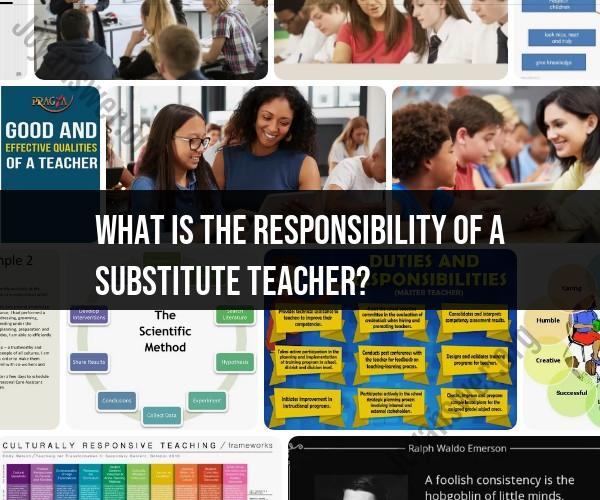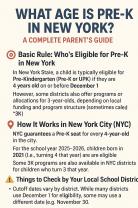What is the responsibility of a substitute teacher?
Substitute teachers play a vital role in maintaining continuity in the educational process when the regular classroom teacher is absent. Their responsibilities include various tasks that contribute to a positive and productive learning environment. Here are common responsibilities of substitute teachers:
Classroom Management:
- Maintain a positive and orderly classroom environment by managing student behavior, addressing disruptions, and ensuring that students follow established rules and procedures.
Follow Lesson Plans:
- Adhere to the lesson plans provided by the regular classroom teacher. This may involve delivering prepared lectures, leading discussions, and assigning and collecting student work.
Adaptability:
- Be flexible and adapt to changes in the daily schedule. Substitute teachers often need to adjust plans based on the needs of the students and any unexpected circumstances that may arise.
Attendance and Record Keeping:
- Take attendance and keep accurate records of student attendance, behavior, and any noteworthy incidents. This information may need to be reported to the regular teacher or school administration.
Instruction and Facilitation:
- Provide instruction and facilitate learning activities. This may include explaining concepts, answering questions, and assisting students with their assignments.
Effective Communication:
- Communicate clearly and effectively with students, school staff, and, if necessary, parents or guardians. Substitute teachers need to convey expectations, provide feedback, and address any concerns that may arise.
Supervision:
- Supervise students during class, transitions, and other activities to ensure their safety and well-being. This includes monitoring behavior in common areas like the cafeteria and during recess.
Maintain Professionalism:
- Uphold a high level of professionalism by dressing appropriately, arriving punctually, and treating students, staff, and administrators with respect.
Emergency Procedures:
- Be familiar with and follow the school's emergency procedures, including protocols for fire drills, lockdowns, and other safety measures.
Leave Detailed Notes:
- Provide detailed notes or a summary of the day's activities for the regular teacher, including information on what was covered, any issues that arose, and student behavior.
Implementing Educational Technology:
- If applicable, use educational technology tools or resources specified in the lesson plans to enhance the learning experience.
Crisis Management:
- Handle any classroom or student-related crises calmly and follow the school's procedures for addressing emergencies.
Professional Development:
- Stay informed about school policies, procedures, and any changes in curriculum. Attend professional development opportunities to enhance teaching skills and knowledge.
Building Positive Relationships:
- Foster positive relationships with students, even if it's a short-term assignment. A welcoming and supportive atmosphere contributes to a positive learning environment.
Substitute teachers are essential members of the educational community, and their ability to adapt, manage the classroom effectively, and provide a positive learning experience is crucial in the absence of the regular classroom teacher.
The Versatile World of Substitute Teaching:
1. Duties and Responsibilities:
- Instruction: Delivering prepared lesson plans or adapting them as needed, providing clear explanations, conducting activities, and assessing student understanding.
- Classroom Management: Maintaining order, addressing disruptive behavior, fostering positive engagement, and ensuring student safety.
- Attendance and Communication: Taking attendance, communicating with the regular teacher and school staff about student progress and classroom events, communicating with parents when necessary.
- Administrative Tasks: Grading assignments, completing paperwork, adhering to school policies and procedures.
2. Managing Discipline and Instruction:
- Establish expectations: Clearly communicate rules and routines from the start.
- Positive reinforcement: Acknowledge good behavior and effort.
- Redirection and de-escalation: Use gentle but firm approaches to address disruptions.
- Flexibility and adaptability: Be prepared to adjust lesson plans based on student needs and time constraints.
- Engage students: Use variety in teaching methods, interactive activities, and humor when appropriate.
3. Creating a Conducive Learning Environment:
- Get to know the students: Learn their names, interests, and learning styles.
- Build rapport: Be approachable, positive, and encouraging.
- Set clear expectations for classroom behavior: Establish a sense of fairness and respect.
- Focus on student engagement: Use clear instructions, visuals, and interactive activities.
- Make learning fun: Incorporate humor, games, and real-world examples where possible.
4. Qualifications and Certifications:
Requirements vary by state and school district, but generally include:
- Bachelor's degree (some districts may accept an associate's degree)
- State-issued teaching certification (often in a specific subject area)
- Completion of substitute teacher training program
- Background check and drug test
5. Challenges and Solutions:
- Unfamiliar classrooms and students: Be prepared to adapt and build rapport quickly.
- Lack of detailed lesson plans: Ask questions, utilize your existing knowledge, and don't be afraid to improvise.
- Student behavior issues: Utilize de-escalation techniques, seek support from staff if needed.
- Limited time to prepare: Make use of resources like teacher websites and curriculum materials.
- Feeling under-appreciated: Remember the vital role you play in keeping education flowing.
Remember, flexibility, adaptability, and a positive attitude are key to thriving as a substitute teacher. By embracing the challenges and utilizing available resources, you can make a significant impact on students' learning experiences.












